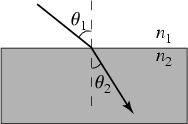Refractions
Key Questions
-
Snell's law is the scientific law of the refraction of light or other waves.
In optical science, Snell's law is about the relationship between the angles of incoming and outgoing light to the refractive indices of the mediums.
The law states that when light passes through different materials (for example from air to glass) the ratio of sines of the incidence (incoming) angle and the refraction (outgoing) angle does not change:#sintheta_1/sintheta_2=v_1/v_2=n_2/n_1# It can also be stated as "The ratio of the sines of the angles of incidence and refraction is equivalent to the ratio of phase velocities in the two media, or equivalent to the reciprocal of the ratio of the indices of refraction".
and be instead written as:
#n_1sintheta_1=n_2sintheta_2# where
#theta_1# and#theta_2# are the angles from the normal of the incident and refracted waves, respectively.
-
Index of refraction is simply:
- The ratio of speed of light in vacuum to speed of light in a medium
- The ratio of wavelength of light in vacuum to wavelength of light in medium.
- The ratio of
#sinTheta# to#sinPhi# . Where#Theta# is the angle in a lighter medium (usually air or vacuum) and#Phi# is the angle in heavier medium.
Your calculations should always be bigger or equal to 1. Otherwise it makes no sense unless you have proven it experimentally (you ought to win the Nobel Prize for that).
Deriving the Index of Refraction is very interesting but I suppose that this would suffice.
-
Are are no such things as "refraction". There is only refraction. Refraction is the bending of light when it passes from one medium to another.
This really cool guy made this really cool video about refraction, check it out!